
l-r, General Konstantin Rokossovsky, Commisar Nicolai Voronov, translator and Field Marshal Frederich Paulus at Don Front Headquarters after Paulus' surrender.

l-r, Field Marshal Fredrich Paulus, commander Sixth Army, General Arthur Schmidt, Chief-of-Staff and Col. William Adam after surrender.
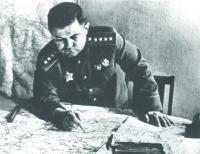
Soviet General Nicolai Vatutin
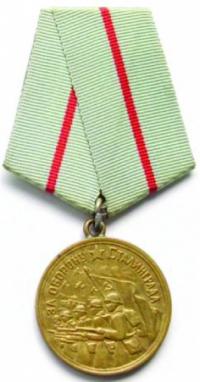
Defense of Stalingrad Medal awarded to 759,500 Soviet soldiers.
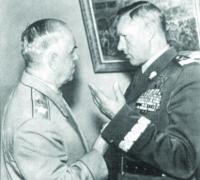
Marshals Zhukov(l) and Rokossovsky(r)
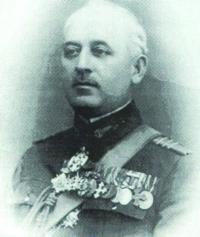
Rumanian General, Petre Dumitrescu

Soviet Stamp honoring Marshal of the USSR Aleksandr Vasilevsky.

Pavel I. Batov wearing TWO Hero of the Soviet Union medals.
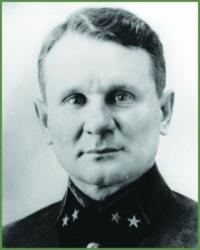
Soviet General Ivan Mikhailovich Chistiakov
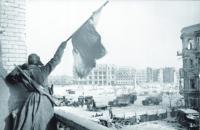
Victorious Soviet soldier waving Red banner in Stalingrad.
This week, 70 years ago, elements of the Soviet Don Front, led by Colonel General Konstantin K. Rokossovsky, met elements of the Southwest Front, commanded by Nikolai F. Vatutin, at the town of Kalach-na-Donu located on the Don River, 45 miles west of Stalingrad, thereby surrounding the German Sixth Army, which was assaulting Stalingrad. The Sixth Army had been grinding away at the city and its heroic defenders led by General Vasilii Chuikov, since August.
A "Front," in Soviet parlance, was the equivalent of an army group. General Vatutin’s Front consisted of the following: First Guards Army, commanded by Dimitry D. Lelyushenko; the 5th Tank Army, commanded by General Prokofii L. Romanenko; the 21st Army, commanded by Major-General Ivan M. Chistyakov; the 2nd Air Army, commanded by Konstantin N. Smirnov; and the 17th Air Army, commanded by Major-General Sczyapan A. Krasovsky. General Rokossovsky’s Don Front contained the following: 24th Army, commanded by General Ivan V. Galanin; the 65th Army, commanded by General Pavel I. Batov; the 66th Army, commanded by Aleksei.S. Zhadov and the 16th Air Army, commanded by Major-General Serhi I. Rudenko.
The Soviet counteroffensive to the German attack on Stalingrad had been planned by Generals Georgy Zhukov and Aleksandr Vasilevsky. They had planned well, beginning with their selection of the respective Commanders - Generals Vatutin and Rokossovsky. They were two of the very best of the Soviet Field Commanders and the point of attack had also been well considered.
On November 19th, General Vatutin’s Don Front attacked to the north of Stalingrad in an area held by the Third Romanian Army, commanded by Petre Dumitrescu. General Dumitrescu’s army had a nominal strength of 160,000 soldiers, including the German 22nd Panzer Division, commanded by Ferdinand Heim. The attack was commenced at 5:30 A.M., by a huge artillery barrage, by almost 6000 guns, along the entire front of the Third Romanian Army, in a blizzard of snow, with the temperature about zero. The results of the barrage actually slowed the Soviet advance, because the artillery had chewed the frozen earth to such an extent that the Red Army’s vehicles had difficulty traversing it.
The next day, General Rokossovsky’s Don Front attacked to the south of Stalingrad in an area defended by the 4th Romanian Army, numbering about 65,000 soldiers, commanded by Constantin Constantinescu-Claps. The 1,100,000 Soviet soldiers, 804 tanks and 13,400 artillery pieces overwhelmed the outnumbered, out-gunned, under-equipped and under-supplied Romanian Armies. The few Czech-built Panzer 35(t) tanks and antitank guns were woefully ineffective against the Soviet T-34 tanks, to say nothing of the overwhelming numerical imbalance in both armor and soldiers. The Rumanians suffered 160, 000 casualties.
Once the Sixth Army, and Stalingrad, were surrounded by the Red Army, Field Marshal Erich von Manstein was transferred from the Leningrad Front to try to assemble a relief force, named Army Group Don. However, almost a month passed before he was able to assemble a force and get it launched. The relief force got within 30 miles of the surrounded Germans but could go no further. General Paulus’ 6th Army had been forbidden to break out because Luftwaffe Chief, Reichsmarshal Hermann Göring had guaranteed the German Führer that the Army’s needs could be supplied by the air, as had been done a year earlier at Demyansk.
But the situation, then, was different. Only a corps was trapped inside the "Demyansk Pocket." The Luftwaffe’s bases were closer. The Soviet Voenno-Vozdushnye Sily was much improved. The Sixth Army’s needs were 300 tons a day. However, the Luftwaffe could not supply even a third of that. General Dr. Baron Wolfram von Richthofen, who was in command of the Luftwaffe units charged with this impossible task, protested directly to the German Führer, who merely smiled and told him that his superior, the Reichsmarshal, had guaranteed that the Luftwaffe could, in fact, supply the beleaguered army, thus sounding the death knell of Sixth Army.
As the Red Army continued to pound away at the trapped Germans, the pocket constricted tighter and tighter, as they slowly starved to death. Army Chief-of-Staff Kurt Zeitzler, in Berlin, reduced his rations to the level of the soldiers at Stalingrad. Within two weeks he had lost 26 pounds, at which point Hitler ordered him to stop.
On January 18, 1943, Georgy Zhukov was named Marshal of the Soviet Union.
Four days later, the Red Army overran the last serviceable airport, ending what few deliveries that managed to get past the VVS and the Russian winter weather. This also meant that the evacuation of the wounded ceased. Now, the only supplies which the Sixth Army received were intermittent airdrops - many of which were recovered by the Red Army.
In an effort to end his soldiers’ suffering, General Paulus, on January 22, 1943, asked Hitler for permission to surrender, which was denied. On January 30, 1943, Hitler made Paulus a Field Marshal. Since no German Field Marshal had ever surrendered, Hitler expected that the new Field Marshal would now conform to this tradition. The next day, the new Field Marshal surrendered, commenting, "I have no intention of shooting myself for this Bohemian corporal!" The Führer was furious, saying that Paulus, "... could have freed himself from all sorrow and ascended into eternity in national immorality, but he prefers to go to Moscow!"
On February 3, 1942, the battle finally ended, when the remnants of the Army surrendered. Included among the 91,000 that shuffled into captivity were 22 generals. Also, 3000 Rumanian soldiers were captured. Of those captured, 27,000 died within weeks and 80 percent were dead in three months. Only about 5000 Germans survived captivity to return to the Fatherland, in 1955, after Stalin had died. None of the Rumanians survived. Two weeks after the surrender Aleksandr Vasilevsky was named Marshal of the Soviet Union.
On May 1, 1945, Stalin recognized Leningrad, Stalingrad, Sevastopol and Odessa as Hero Cities. This status was made official by the presidium of the Supreme Soviet of the U.S.S.R. on May 8, 1965. In October of 1967, the Statue of Mother Russia was erected on Mamayev Hill, the highest point in Stalingrad. At the time of its dedication, it was the tallest sculpture in the world, measuring 279 ft. from the tip of its sword to the top of the plinth and weighed 7,900 tons.
NEXT: THE DESTRUCTION OF THE ITALIAN EIGHTH ARMY
Mr. Wimbrow writes from Ocean City, Maryland, where he practices law representing those persons accused of criminal and traffic offenses, and those persons who have suffered a personal injury through no fault of their own. Mr. Wimbrow can be contacted at wimbrowlaw@gmail.com
«Go back to the previous page.









